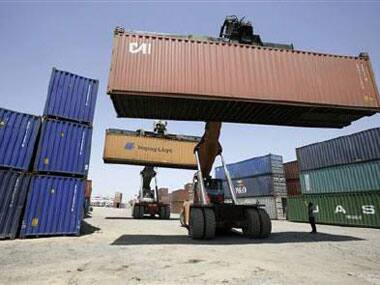It was a bad end to the year for India’s external trade as exports in March slipped for the first time since 2009 as a sluggish US recovery and the ongoing European sovereign debt crisis dampened appetite for Indian goods and services.
Exports fell 5.7 percent to $28.7 billion from a year ago, while imports rose 24 percent to $43 billion.
For the financial year ending March 2012, the trade deficit (the gap between exports and imports) shot up to an alarming $185 billion, the highest figure in Indian trade history. The deficit is also equivalent to 9.9 percent of GDP.
Both deficits (monthly and annual) were more bad news for the country, and follow a lowering of India’s sovereign rating outlook to negative from stable by ratings agency Standard and Poor’s.
So, what can we expect going forward?
One, the outlook for exports remains grim.
Don’t expect much changes on this front. Rahul Khullar, India’s trade secretary, warned earlier that exporters could continue to face a tough year because of tough global economic conditions. So, don’t expect economic growth to be boosted from this front.
Two, imports are likely to remain high.
Oil imports, India’s biggest import item, will continue to be high given that it imports more than 80 percent of its crude oil
[caption id=“attachment_295116” align=“alignright” width=“380” caption=“india imports and exports look grim. Reuters”]
 [/caption]
[/caption]
requirements. Crude prices continue to hover at high levels currently – at around $117 a barrel – and will continue to weigh on the trade deficit.
Three, pressure on the rupee will remain.
The wide trade gap and resulting persistent current account deficit (trade gap+ net foreign inflows) will keep putting pressure on the rupee, which has already tumbled 19 percent against the US dollar in the past 12 months. The current account deficit, which indicates India’s net indebtedness to the world, is currently estimated at an alarming 3.7 percent of GDP.
The fact that we are earning less foreign exchange than we need to pay for our imports will keep hammering the value of the rupee against foreign currencies.
Four, inflation will continue to rattle the economy.
A weaker rupee and a continually high level of imports will increase the threat of ‘imported’ inflation. For companies, the prices of imported inputs could stay high and that might keep the squeeze on margins and keep corporate profits depressed. If companies pass on the increase in costs to consumers either in part or full, consumer spending might face cuts. Fuel price hikes also, in the works for some months now, will add to inflationary pressures.
That will leave very little room for the Reserve Bank of India to cut rates further. The central bank cut key lending rates for the first time in three years last month after GDP expanded by just 6.1 percent in the December-ending quarter, its slowest pace since 2009. But it may be prevented from starting a long rate-cutting cycle.
Five, foreign investor inflows could dry up.
A wide current account deficit will frighten foreign investors. As this Reuters column notes, “During most of the last decade, the current account deficit has been funded without great difficulty. Foreign direct investment, portfolio investments and about $60 billion a year of remittances have usually exceeded the shortfall in trade.”
Unfortunately, given the slowdown in economic growth and a recent spate of tax proposals that seem designed to drive foreign investors away, India can’t depend on foreign inflows to make up that trade shortfall anymore. A weak rupee is complicating matters further.
If foreign investors choose to exit the country en masse and the CAD continues to widen, India could be in big, big trouble for funds
Yes, the poor trade data represents bad news for us all.
)